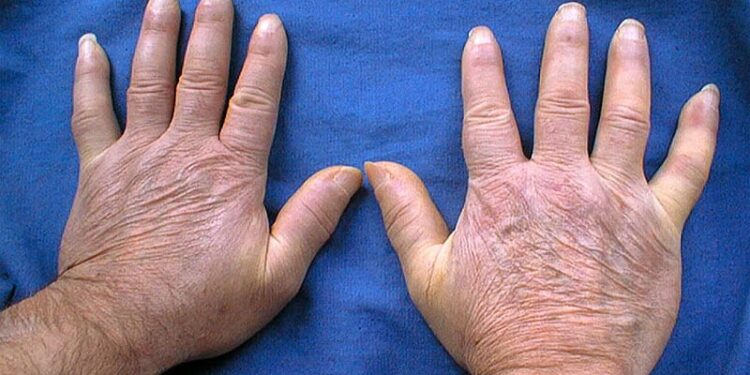[ad_1]
TOPLINE:
Type I interferon (IFN) score may effectively predict disease progression in limited cutaneous systemic sclerosis (lcSSc), with patients having a high IFN activity presenting worse clinical outcomes.
METHODOLOGY:
- Researchers conducted a longitudinal retrospective analysis to investigate whether the serum IFN score could predict clinically meaningful progression in patients with lcSSc using a novel composite endpoint calculated using serum biomarkers.
- Overall, 149 patients with lcSSc (mean age, 60 years; 96% women; median disease duration, 8 years) were recruited between December 2013 and November 2019 from a single center in the United Kingdom and followed up for a median duration of 88 months.
- The IFN score was calculated on the basis of the serum concentration of six chemokines (CCL2, CCL8, CCL19, CXCL10, CXCL9, and CXCL11), with a “high” IFN score being defined as two SDs above the mean score calculated on 72 matched healthy control individuals.
- Time to clinical worsening was measured using the composite Morbi-mortality endpoint derived in a previous trial, which included disease-related mortality and organ manifestations.
TAKEAWAY:
- Compared with healthy control individuals, patients with lcSSc had a significantly higher concentration of serum chemokines leading to a significantly higher IFN score (5.5 vs 4.97; P less than .001) with 67 patients classified as having a high IFN score.
- Compared with patients with low IFN scores, those with high scores demonstrated significantly shorter time to clinical worsening (110.6 months vs 74.7 months; P less than .001) and a higher event probability (P ≤ .024 till 120 months).
- Patients with high IFN scores faced more than sixfold higher hazard of Morbi-mortality events over time than those having low IFN scores (hazard ratio, 6.20; P less than .001).
- Baseline characteristics that were significantly associated with an increased odds of worsening clinical events included the presence of pulmonary artery hypertension, interstitial lung disease, digital ulcers, modified Rodnan skin score, and age (P ≤.001 for all).
IN PRACTICE:
“Type I IFN activation is common in SSc extending to both cutaneous subsets, and that IFN score may aid in the assessment of disease activity and in enriching for higher probability of clinically meaningful events over time also in lcSSc trials,” the authors wrote.
SOURCE:
This study was led by Stefano Di Donato, MD, Leeds Institute of Rheumatic and Musculoskeletal Medicine, University of Leeds, Leeds, England. It was published online on January 29, 2025, in Arthritis & Rheumatology.
LIMITATIONS:
The retrospective nature of this study made it susceptible to information bias, potentially underpowering the analysis by censoring patients with milder phenotypes. While the sample size was calculated to detect differences in event-free survival between lcSSc groups, the validation of the proposed multivariable model metrics requires a larger pool of patients.
DISCLOSURES:
This study was supported by a grant from the Biomedical Research Centre of Leeds, National Institute for Health and Care Research.
This article was created using several editorial tools, including AI, as part of the process. Human editors reviewed this content before publication.
[ad_2]
Source link : https://www.medscape.com/viewarticle/blood-test-unveils-disease-course-limited-cutaneous-systemic-2025a10002xw?src=rss
Author :
Publish date : 2025-02-06 08:14:53
Copyright for syndicated content belongs to the linked Source.














